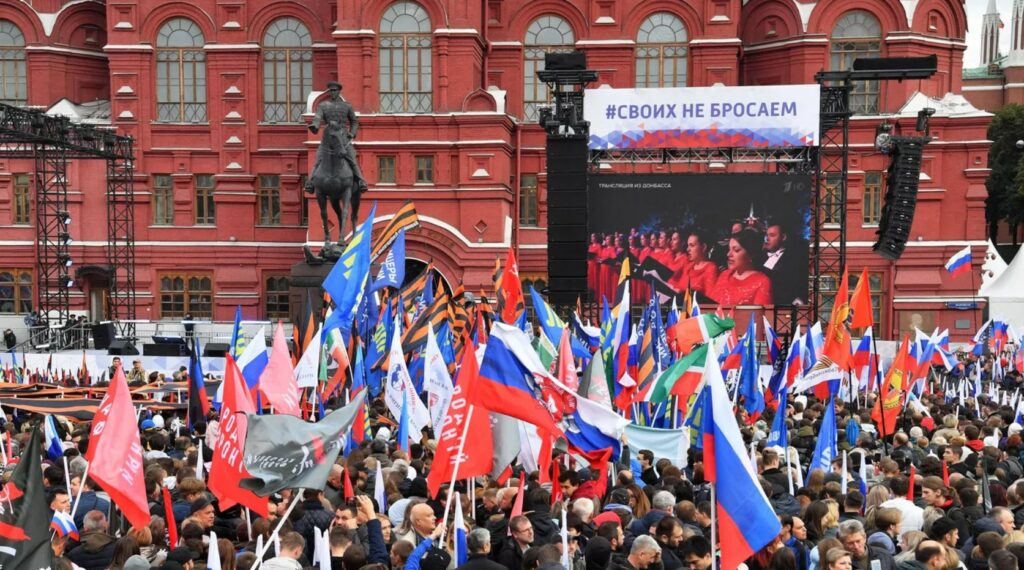On September 23, the most intense fighting between Russian forces and pro-Kyiv formations continued in the sector of Lyman, northeast of Slavyansk. After the ‘Kyiv’s counter-offensive’ around Izum, the frontline stabilized along the Rubtsi-Drobishevo-Mayaki-Yampol-Serebryanka line. In the past few days, Kyiv’s forces repeatedly tried to break the Russian defense there but major losses were all what they gained.
Reports claimed that the most recent attack took place around the village of Yacivka around Rubtsi. An intense fighting is ongoing in this area with Kyiv’s forces claiming the control over Yacivka and thus progress towards Rubtsi.
Another hot point is Drobishevo. On September 22, Kyiv’s units briefly entered the village, but as of September 23 they were faced to retreat from there.
On the same day, the Russian Defense Ministry released a fresh report on the situation on the frontlines:
The Armed Forces of the Russian Federation continue the special military operation.
High-precision attack of Russian Aerospace Forces launched at the units of 81st Airmobile Brigade near Kramatorsk (Donetsk People’s Republic) has resulted in the elimination of over 220 Ukrainian servicemen.
Fire attack has been launched at the units of foreign mercenaries near Slavyansk and Ozyornoye (Donetsk People’s Republic). The attack has resulted in the elimination of over 100 militants.
Russian Aerospace Forces have launched high-precision attacks at the positions of Chayka tactical group near Zaporozhye, as well as at the provisional bases of Skif, Dnepr and Gepard nationalist battalions.
The attacks have resulted in the elimination of over 190 militants and 12 units of military equipment.
Operational-tactical and army aviation, missile troops and artillery have neutralised the provisional bases of 59th Mechanised Infantry and 63rd Mechanised brigades near Bezymennoye and Ternoviye Pody (Nikolayev region). The enemy has lost over 130 servicemen.
The list of the neutralised targets includes 4 command posts: one of 14th Mechanised Brigade of the Armed Forces of Ukraine (AFU) near Dvurechnaya (Kharkov region), 9th Regiment of the National Guard near Primorskoye (Zaporozhye region), as well as the command and observation posts of 2nd and 3rd battalions from 65th Mechanised Brigade near Novoandreyevka and Verkhnyaya Tersa (Zaporozhye region).
74 artillery units, 142 AFU manpower and military equipment concentration areas have been neutralised.
3 missile, artillery armament and munitions depots have been destroyed near Zaporozhye, Monachinovka (Kharkov region) and Donetskoye (Donetsk People’s Republic).
1 Ukrainian Buk-M1 self-propelled system has been destroyed near Nikiforovka (Donetsk People’s Republic).
Fighter aviation of Russian Aerospace Forces has shot down 1 Ukrainian MiG-29 airplane near Novosyolovka (Nikolayev region), as well as 2 Su-25 airplanes of Ukrainian Air Force near Vesyoloye (Kherson region) and Kamyshevka (Donetsk People’s Republic).
Russian air defence facilities have shot down 19 Ukrainian unmanned aerial vehicles near Novaya Kakhovka, Tomarino, Novoraysk, Shlyakhovoye, Mirolyubovka, Belyayevka, Kreshchenovka, Bruskinskoye and Chkalovo (Kherson region), Lyubimovka (Zaporozhye region), Valeryanovka, Tripolye, Vladimirovka, Gornoye, Khartsyzsk, Novoaleksandrovka, Yevgenovka, Terny and Krasnaya Polyana (Donetsk People’s Republic).
Air defence facilities have also destroyed in air 42 rocket-propelled projectiles launched by U.S.-manufactured HIMARS multiple rocket-launching system (MRLS), as well as by Olkha MRLS, near Plodovoye and Novaya Kakhovka (Kherson region).
In total, 298 airplanes and 155 helicopters, 2,054 unmanned aerial vehicles, 376 air defence missile systems, 5,077 tanks and other armoured combat vehicles, 844 combat vehicles equipped with MRLS, 3,410 field artillery cannons and mortars, as well as 5,794 units of special military equipment have been destroyed during the special military operation.
Additionally, loitering munitions ‘Geran-2’ (a local name for Iranian-developed Shahed-136) of the Russian Armed Forces carried out a strike in the port city of Odessa. According to photos from the area at least one Geran-2 struck a military target in the port area.
Pro-Kyiv sources also claimed that two Geran-2 munitions were employed in the area of Dnepropetrovsk (Kyiv authorities renamed the city into Dnipro).
Meanwhile, referendums on officially becoming a part of Russia started in the Donetsk and Lugansk People’s Republics as well as in Kherson and Zaporozhie Regions. The voting is taking place from September 23 to 27. The voting is held in the state of a permanent threat from Kyiv’s forces that regularly and intentionally shell civilian targets there. This is why the important part of the voting takes place in the format of home-to-home (door-to-door in the case of apartment) votes. Authorities try to prevent creating of large crowds for voting because they will become targets of strikes of Kyiv’s forces. Therefore, the voting process is set to take several days.
The voting on reunion with Russia is the key turning point in the fate of these regions after the fall of the USSR. Taking into account the posture of Kyiv’s regime towards civilian population, it is easy to expect how population of these regions will choose to vote. Furthermore, together with the partial mobilization in Russia itself, these developments show an important shift in actions of the Russian leadership towards the conflict.









Neo Nazi Ukrainian counter offensive is losing steam!
The nazis also lost steam in auntum and they got crushed in the russian winter starting in 1941. Expect russia to crush the azov nazis this winter. Most of russias conservative approach was due to understrenght of their units at just 20% many vehicles few infantrymen. Now these units are replenished with mobilization units as intended. Their fighting effectiveness will be much higher. Meanwhile ukraine is desperately crying for more and more equipment from nato suppliers. They are on the brink. They cannot match full strength russian units. They will be squashed like bugs.
Soviet style farce elections. Just read history how “Baltic States wanted to join Soviet Union”. Another propaganda operation run by Rooskies. 😭🤣😂
You talk a lot of shit just like your partner @joe
Making more income each month from domestic extra than $26k simply with the aid of using doing easy reproduction and paste like on line activity. I even have received $18635 from this clean (nau-30) domestic activity Everybody can now makes more money on line without difficulty with the aid of using. simply follow_______𝗵𝗼𝗺𝗲𝗰𝗮𝘀𝗵𝗯𝗼𝘅𝟭.𝗯𝗹𝗼𝗴𝘀𝗽𝗼𝘁.𝗰𝗼𝗺/
US and UK has been planning to destroys Russia Ukraine EU and China even EU because EU is competitor of US and UK trade.
Home-to-home voting? Is this a joke? Ukraine wouldn’t dare to shell a voting center. It would shatter the international illusion that they even pretend to be a “democracy”.
This was a serious miscalculation of the RF. Maybe they were afraid of a contested vote?
Well done!! Free Donezk!
Bomb Headquarters in Kiev, get rid of leadership
Well, high precision HIMAR missiles just hit a hotel in Kherson, killing two.
I’m sure Kiev is soon to be on the dinner menu.
Russia set free Azov nazis. What kind of “war” is this?! Did Stalin set nazis free?!
Reunion?
To those in the west who can’t manage to see the forest for the trees, allow me to clarify things via a simple and almost perfect analogy from recent history:
Serbia does not to this day recognize Kosovo’s independence, correct?
Let’s then suppose that Serbia, with Russia’s military assistance, had been for the past two decades shelling Pristina, killing civilians and more recently, using Russian supplied high precision missiles to target civilian infrastructure in the heart of Pristina, again with civilian casualties. All the time, Russia declaring that Serbia’s borders were inviolate and would assist Serbia militarily in support of its actions. How would the West react to this?
This is exactly what Ukraine and those assisting it have been and are now doing.
I say, to hell with them.
Western economy has been surprisingly stable and strong since Feb 2022. During the last 2 months energy prices have started to go down and inflation peak of spring is over. At the same time clouds are thick and dark above Russian economy. The winter is coming but EU is clearly surviving. Kreml has reasons to be very scared.
There seems to be no century Russia not collapsing at least once or twice. 1917, 1991… 2023? Unstability, cringing population behaviour, dictatorship is the nature of Russia and Russians. Vodka and Genghis Khan have shaped Russians.